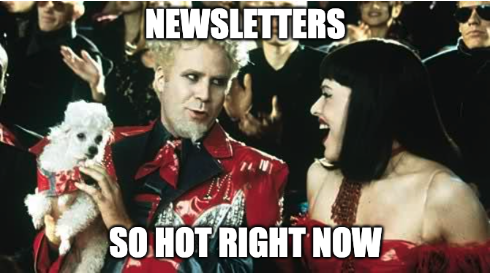Newsletters fascinate me as a media product. They're simple, efficient, and perhaps a bit overhyped.
So why are newsletters are such an effective medium?
Newsletters "work" as a media product for three reasons:
- They're personal.
- They're predictable.
- They're scarce.
Why they work for readers
They're personal.
Newsletters convey a conversational tone from a familiar voice. This aspect, delivered consistently, creates a relationship. Reading a well-written newsletter should feel like hearing from an interesting friend.
While newsletters are personal, they don't need personalization. There are enough newsletters out there to "scratch every niche." This empowers readers to find voices that feel personal to them.
In a recent Audience Builders, Dan Shipper from Every spoke about how newsletters resonate with the vibe of an audience:
They're predictable.
Like periodicals and TV shows before, newsletters publish on a regular schedule. For audiences, this creates an expectation. They'll receive a specific amount of content, in a consistent format, delivered right to their inbox.
Fans of James Clear's Atomic Habits will recognize that newsletters by nature meet two of the key criteria of habit building:
- Make it obvious: newsletters live in the inbox where readers already spend time, and are by nature obvious.
- Make it easy: Once you subscribe, you don't need to seek anything else out. You just open and read.
The other two criteria, "make it attractive" and "make it satisfying", are up to the writer. If they can create a positive and fulfilling experience for the reader, they'll cement their newsletters as a habit.
They're scarce.
Newsletters publish anywhere from once a week to at most daily. Not too much, not too little. Just right.
People who complain of newsletter overload are mostly media junkies. They signed up for too much of a good thing, and live with the consequences.
There are easy antidotes to this: Read only what you want. Batch consumption. Or if all else fails, unsubscribe.
In a world of overwhelming content delivered at random via algorithm, a predictable newsletter with a personal voice delivered with the right amount of scarcity becomes a respite of familiarity.
Why newsletters work for writers
They're personal.
Newsletters focus on hyper-niche subject matter written in first person. For a writer, this encourages authentic expression. It's no coincidence that newsletters are a primary medium of "the Passion Economy."
Blogs share this quality, but the business model for a blog is suboptimal. A blog with thousands to tens of thousands of readers has limited options for monetizing. A newsletter with a similar audience can do quite well selling subscriptions or sponsorships. Incidentally, a newsletter with a companion blog is a great model.
Newsletters also create community. Authentic conversations can develop between writer and reader. This leads to a more rewarding experience for the writer than publishing into the void.
They're predictable.
Putting out a consistent product to the same audience on a regular schedule reduces noise. This results in a cleaner data set, with tight feedback loops.
Writing for the web can create fuzzy signals. A story may go viral for unclear reasons. A quirk of the algorithm. The right influential person happens to share at the right time. Chasing repeat wins often leads to wasted effort.
With a newsletter, the signals are clear:
- Are subscribers opening?
- When they open, do they click?
- Are they sharing the newsletter with others?
- Are subscribers increasing?
- Is churn low?
These metrics are easy to track and tell a predictable story.
They're scarce.
Writing a newsletter enforces consistency and moderation. The writer publishes on a fixed schedule. At most, they hit send once per day. Contrast that with many online writers who publish several times per day.
The slower cadence shifts the onus from speed to insight. When a writer doesn't need to publish takes when they are still steaming hot, she can wait for stories to develop. She can look for deeper meaning. She can put ideas into broader context. She can connect the dots between multiple stories.
Of course newsletter writers can still miss deadlines, battle writers block, and feel the creep of burn-out. But due to their inherent scarcity, newsletters have built-in guardrails to prevent the worst.
Why newsletters work as a business
They're personal.
The personal nature of newsletters makes them prime vehicles for both ads and subscription.
The best newsletter ads assume the same conversational tone as the rest of the content. The audience has a relationship with the newsletter, so there's a high level of trust.
Newsletter ads are endorsements. For a writer to accept a brand as a sponsor, they need to believe in the product. Brands who clear that hurdle typically see great results. Which is why you'll often see the same brand sponsoring a newsletter over and over again.
Subscriptions work well because readers have a personal relationship with the writer. They aren't paying only for the content, they're also supporting the creator. Becoming a supporter often comes with opportunities to deepen the relationship with the writer through greater access.
They're predictable.
Because newsletters by nature are a consistent product on a regular publishing schedule, predicting their revenue trajectory is much more straightforward. This aids in everything from pricing and planning sponsorships to projecting subscription revenue growth.
Newsletter advertisers tend to be more performance focused. And if your newsletter performs well with a high open rate and a good click-through-rate, then your ads metrics will likely follow suit. In contrast, the performance of web inventory and branded content can be much more volatile.
For potential subscribers, predictability is a big selling point. They know they'll receive new issues on a consistent schedule in a similar format from the same writer.
They're scarce.
This is where the real magic of newsletter monetization works. Scarcity and urgency are secret weapons.
One of the biggest challenges for selling web advertising is creating urgency. In a world of infinite content and inventory, publishers need to create urgent situations to woo advertisers. Which is why you see so many seasonal programs, recurring annual features, and campaigns tied to one-off events.
None of this is necessary with a newsletter. You send out only so many issues per week. Those issues have limited ad space. Once an issue gets sent, the ad opportunity expires.
This combination of scarcity and urgency puts natural pressure on the advertiser. Use it to your advantage, and you'll soon start selling out inventory weeks in advance. Which means you can raise prices or increase the scope of your deals.
Scarcity works well for subscriptions as well. Higher volume web publications often struggle deciding what to put behind the paywall. Hence the rise of metered paywalls.
With less content, newsletters can set a clear line between free and paid content. With a lighter publishing schedule, writers can invest more time into differentiated subscription content.
For readers, scarcity can be a big motivation to subscribe. If they enjoy a once a week free email enough, they have a big incentive to pay for a second or third email every week.

Newsletter are so hot right now, there is a lot of talk about how to further optimize the experience. That could mean unbundling newsletters out of the inbox into a standalone app. Or trying to build in more social components.
But the simplicity of newsletters is what makes them so effective. Taking them out of the inbox would make them less personal. Introducing social sharing and algorithmic sorting would make them less predictable. Amping up their discoverability would make them less scarce.
Rather than trying to change newsletters, we should make other media products more like them. If you're working on something new in media, evaluate what you're working on and ask yourself:
- Is it personal?
- Is it predictable?
- Is it scarce?



